For all Brinjal or Eggplant lovers, here is a traditional recipe of Stuffed Brinjal hailing from the Maharashtrian cuisine. Know as Bharli Vangi in Marathi, this dish features stuffed small brinjals in a gravy base of coconut, sesame seeds, peanuts, onions, tomatoes and spices. One of my favorite Brinjal Recipes, Bharli Vangi is also a vegan friendly preparation. This one is regular at my home. And I’m sure, once you try it, it’ll be the same at your home too.
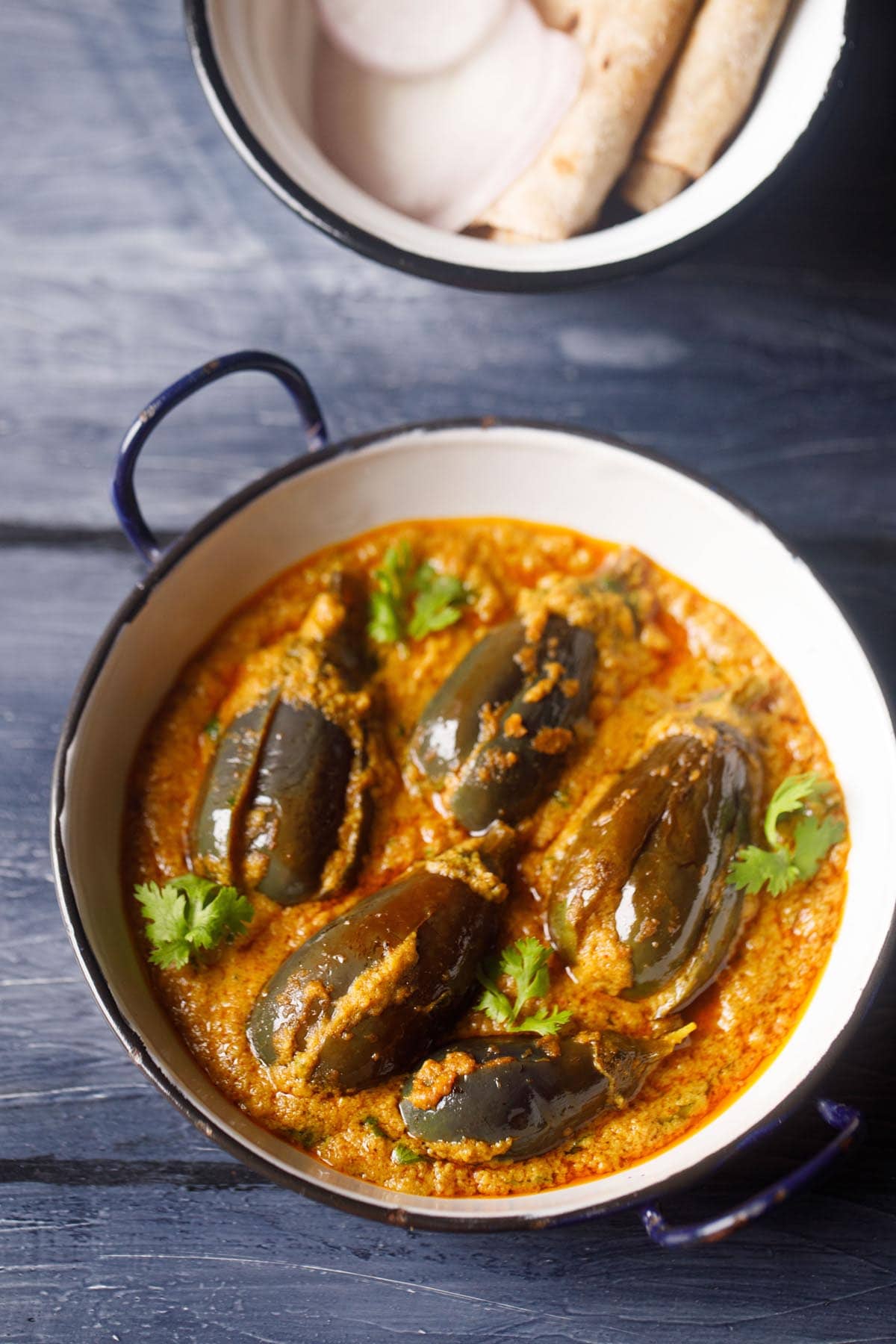
About Bharli Vangi
Bharli Vangi is a classic brinjal recipe from the cuisine of Maharashtra and this one especially, is how my mother prepares it. In Marathi language, the word ‘bharli’ means ‘stuffed’ and ‘vangi’ is ‘brinjal/aubergine/eggplant or baingan.’ Hence, the dish is rightly named so.
Just like this Bharli Vangi made with brinjal, other vegetables like Okra (Bhendi), Bitter Gourd (Karela), Capsicum (Shimla mirch), potato, large green chilies, pointed gourd, bottle gourd etc. are also used to make ‘stuffed’ or ‘bharli/bharwan’ dishes.
Stuffing vegetables and turning them into flavorful dishes is a common thing in Indian cuisine. There are a variety of filling mixtures that vegetables can be stuffed with.
For instance, it can be a spice mixture, grated paneer or cottage cheese or even minced soya mixtures. These mixtures can be cooked and stuffed, or stuffed and then finally cooked in the veggies.
If you love having stuffed brinjal as a dish, then along with this Maharashtrian style Bharli Vangi, you should also try these recipes of Bharwa Baingan from North Indian cuisine, the Gutti Vankaya from the Andhra cuisine and the Ennegayi from the Karnataka cuisine.
There are major differences in all these variations, considering the varied ingredients used and the methods of preparation. These differences make each of the Stuffed Brinjal variant from these regional Indian cuisines, taste unique and distinct.
More My Recipe
This Bharli Vangi is a complex recipe to make. Cooking the brinjal or eggplant does not take much time. It is the preparation and stuffing that takes some time. You can even choose to add the brinjal in the chopped way. Check out the tips section to know how.
Some of the typical ingredients that makes this Bharli Vangi Maharashtrian are peanuts, sesame seeds and coconut. These are roasted first and then ground with chopped onions, ginger and garlic into a smooth and thick paste.
This paste is what is used as a rustic mixture to stuff the brinjals. Also, if you are making the dish with chopped brinjals, this paste will add body to the gravy.
The stuffed brinjals are then simmered and cooked in a masala curry base of onions, tomatoes and various ground spices.
For the Bharli Vangi, we need to use baby eggplants or small eggplants. This type is easily available in India. If you still have to make this recipe and do not have baby eggplants, you can then buy medium-sized eggplants, chop them and make this recipe.
Bharli Vangi pairs really well as a side dish with Indian flat breads like phulka, chapati, bhakri, paratha, poli, or even bread and steamed rice.
How to make Bharli Vangi
Preparing Brinjals
1. Rinse 250 grams of small brinjals first. Slit them on 4 sides without breaking them apart. You can keep a portion of the stems, if you prefer.
Slightly pull apart the brinjal wedges and check to see if there are any worms in them. If you see black spots or worms, trash the brinjal.
Ensure to use small or baby brinjals. Usually to make this recipe, the small brinjals having tiny thorns are used.
Locally in Marathi language, they are called “kateri vangi“, where the word ‘kateri‘ means ‘thorny’ or ‘with thorns’.
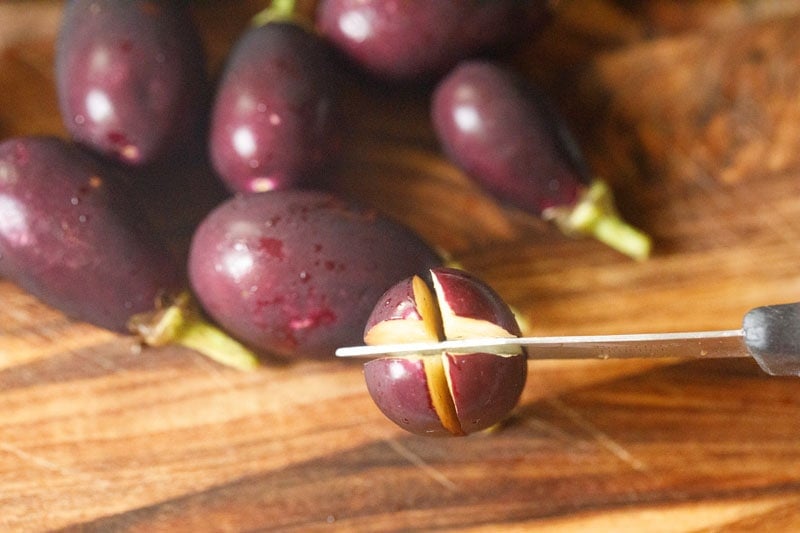
2. Soak in salted water for 15 minutes. You can also chop them and soak in salted water. Soaking in salted water removes the bitter flavor from brinjals.
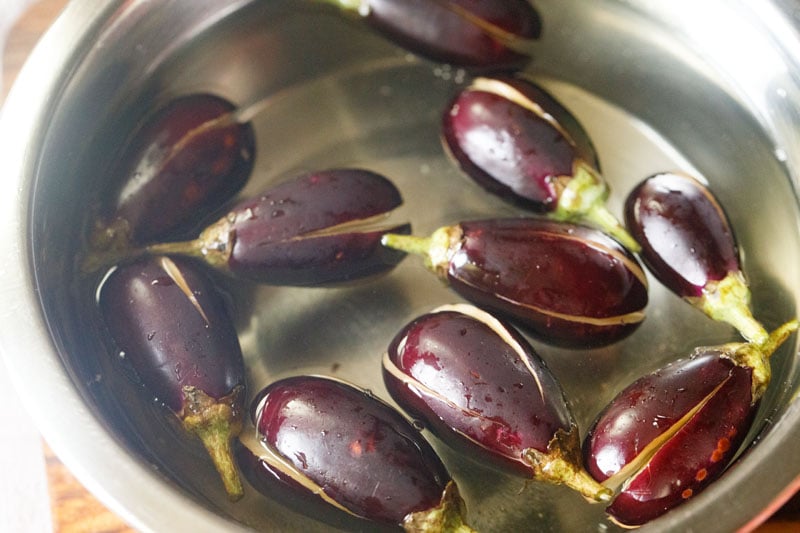
Make Stuffing Masala
3. In a frying pan or kadai (wok), dry roast ¼ cup peanuts on medium-low to medium heat.
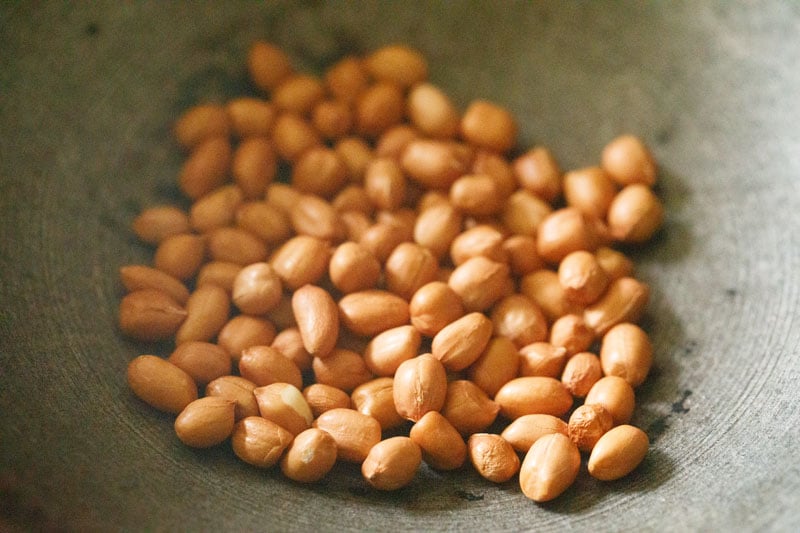
4. Roast them until you see some blisters on them and they become crunchy.
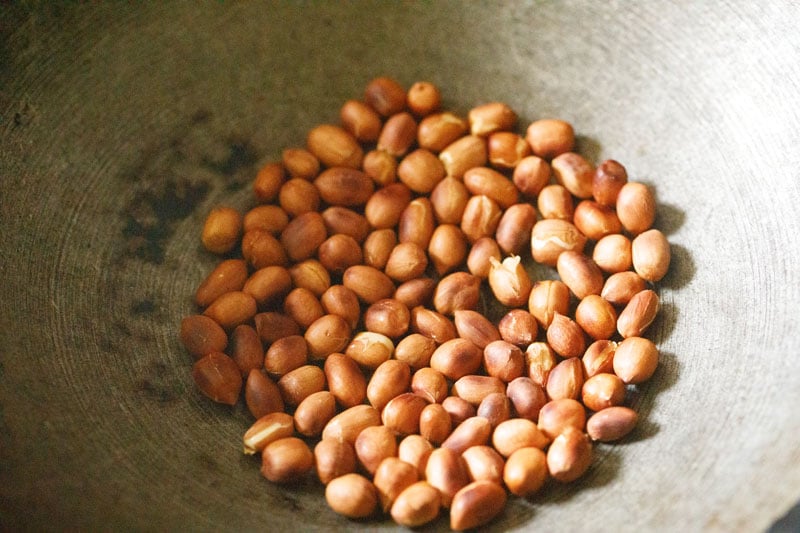
5. When they get browned, add 1 tablespoon white sesame seeds.
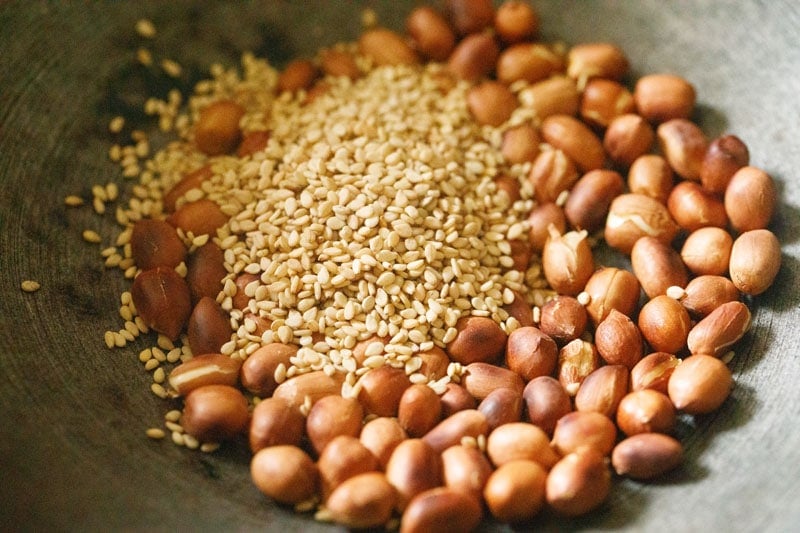
6. Next, add ½ cup desiccated coconut or unsweetened shredded coconut. Mix and begin to roast the coconut stirring non-stop.
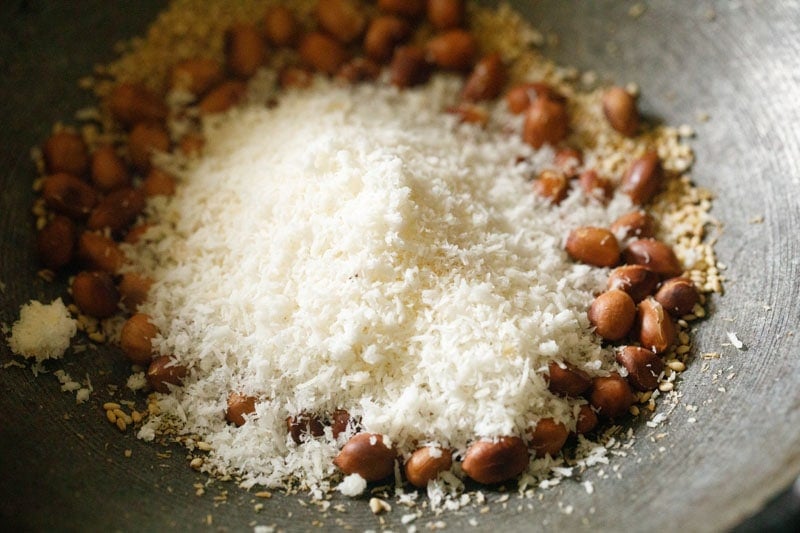
7. When coconut turns light golden, add 5 to 6 small to medium chopped garlic cloves and 1 inch peeled and chopped ginger.
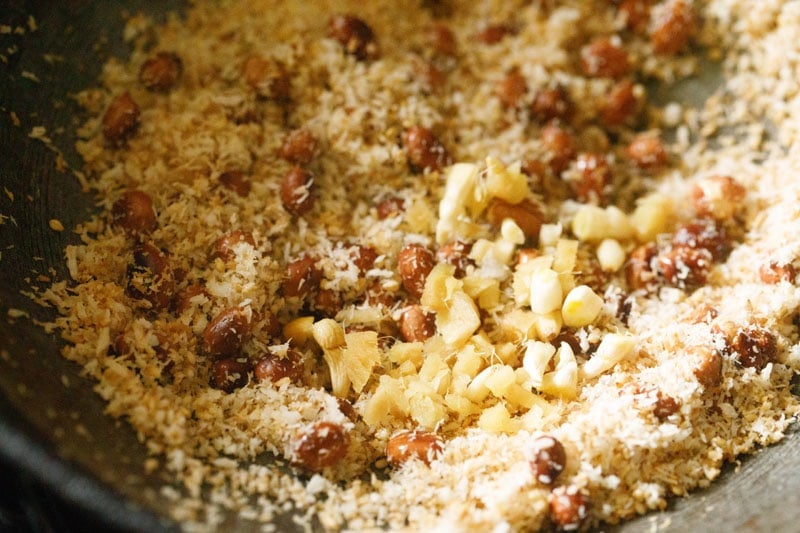
8. Roast stirring non-stop until the coconut is browned and turns fragrant. You can also choose to roast each ingredient separately.
Set aside this mixture to cool at room temperature.
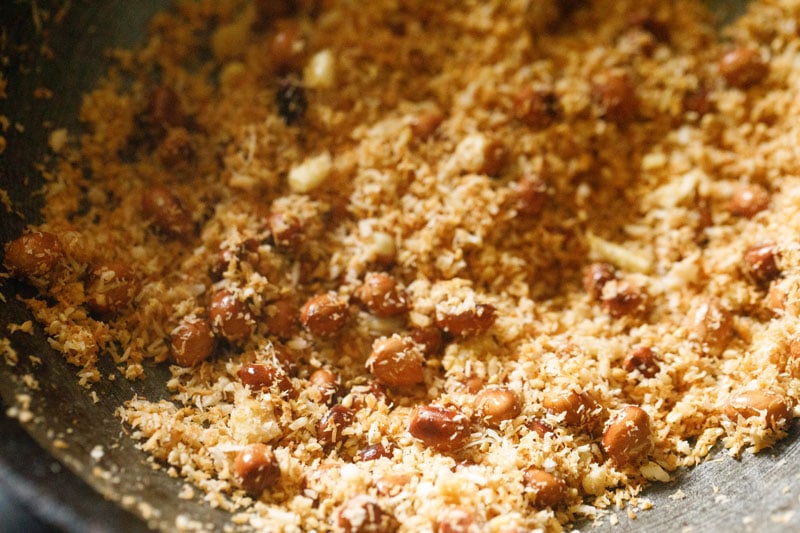
9. When the coconut, peanuts and sesame seeds cool down, add them in a high-speed blender or grinder with ¼ cup roughly chopped onions.
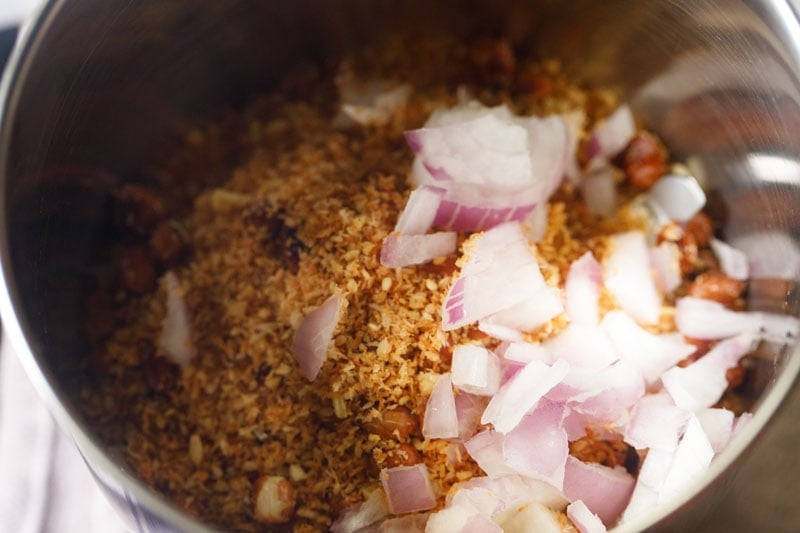
9. Grind to a smooth and fine paste with 4 to 5 tablespoons water. Make a thick paste. Do not add too much water while grinding.
If the paste gets a loose consistency, it will be difficult filling it in the brinjals.
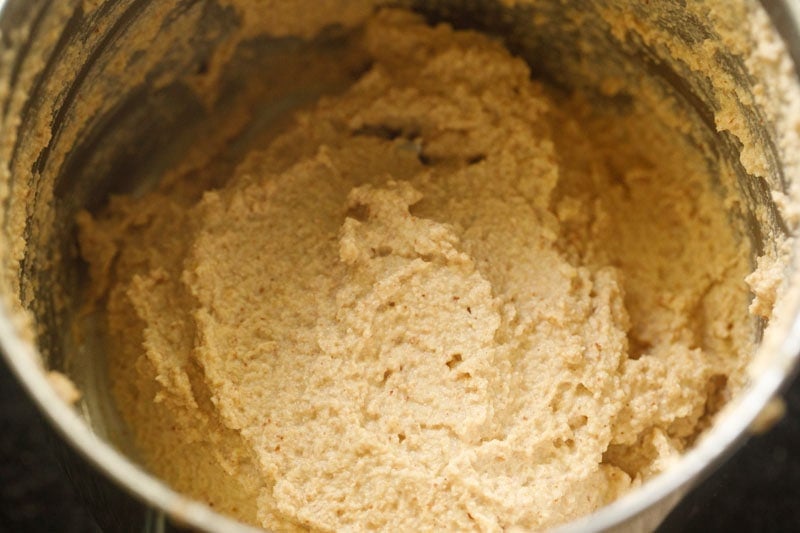
Stuff Brinjals and Sauté
10. Drain all the water from the brinjals. Place the brinjals on a plate or chopping board. Pat them dry with clean kitchen towel, if you prefer.
With a spoon, stuff the prepared masala paste inside each brinjal. Keep aside.
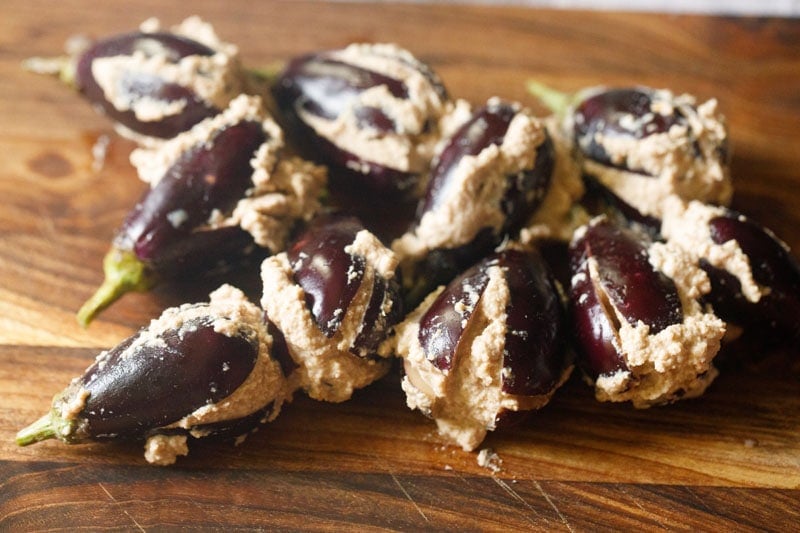
11. In pan, heat 3 to 4 tablespoons peanut oil. Add ¼ cup chopped onions.
Instead of peanut oil, use sunflower oil or any neutral tasting oil.
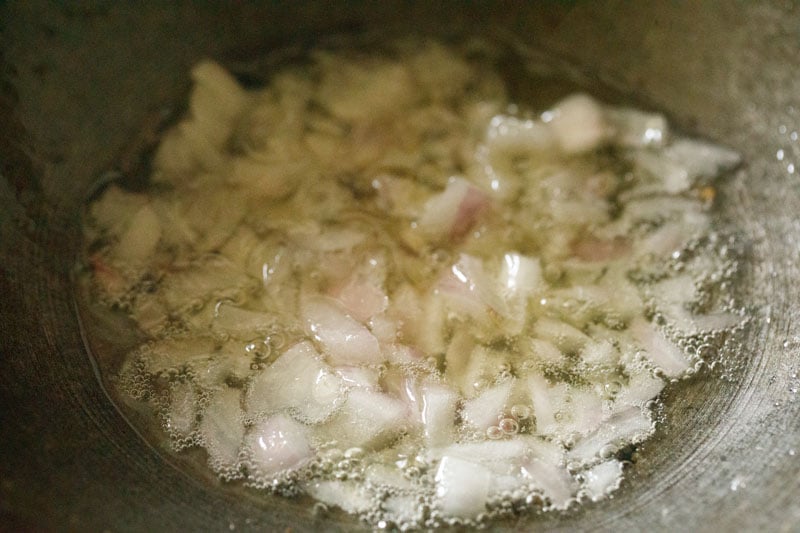
12. Sauté onions on low to medium-low heat till they turn light golden.
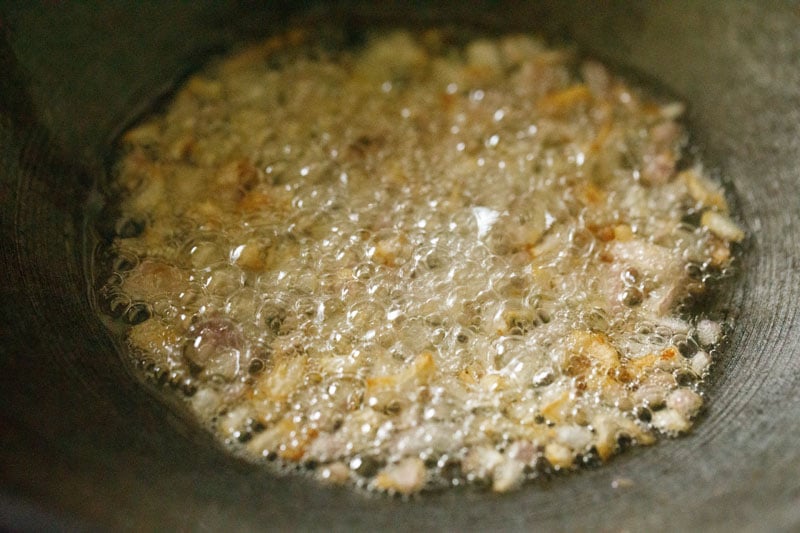
13. Next, add ½ cup chopped tomatoes.
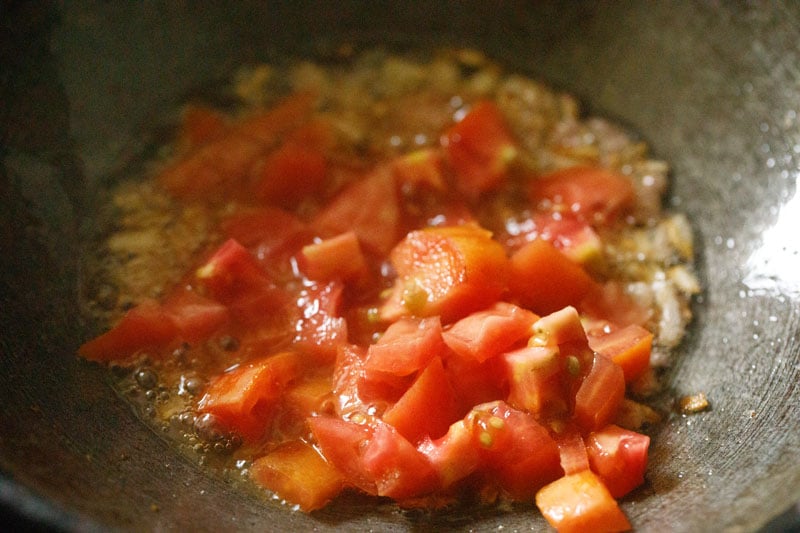
14. Mix and sauté till the tomatoes soften and turn mushy.
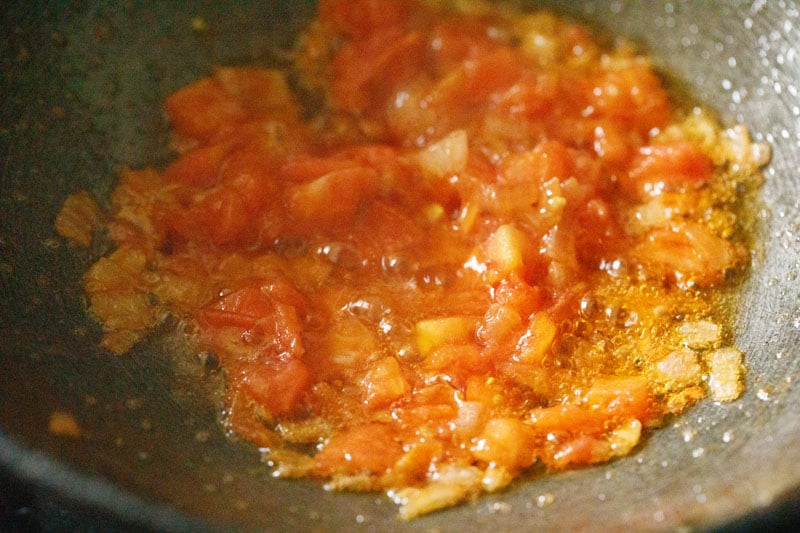
15. Add the following spice powders one by one:
- 1 pinch asafoetida (hing)
- ½ teaspoon turmeric powder
- ½ teaspoon Kashmiri red chili powder
- ½ teaspoon coriander powder
- ½ teaspoon cumin powder
- 2 teaspoons Goda Masala or swap with ½ teaspoon Garam Masala
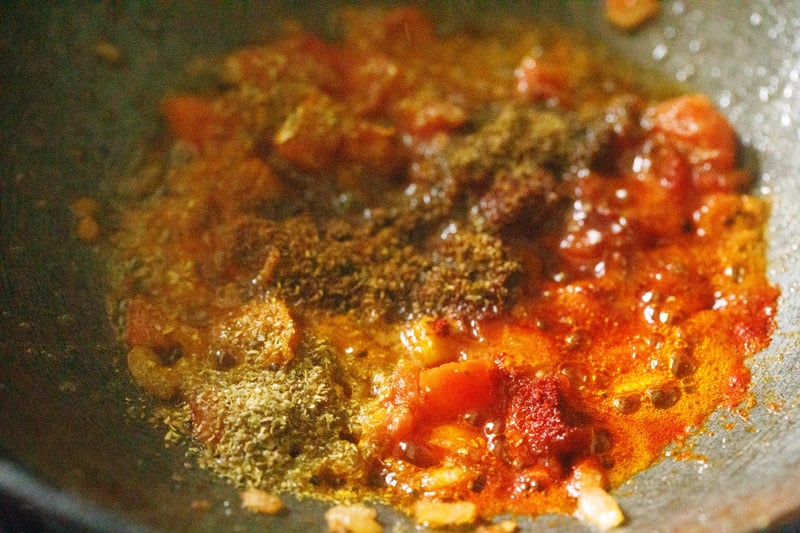
16. Stir to combine and mix. Sauté on low heat for some seconds till you get a nice aroma.
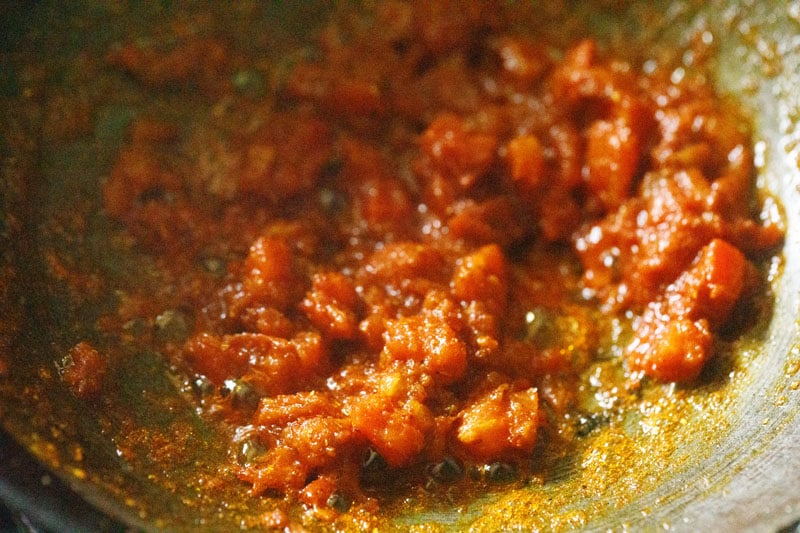
17. Add remaining leftover coconut and peanut paste.
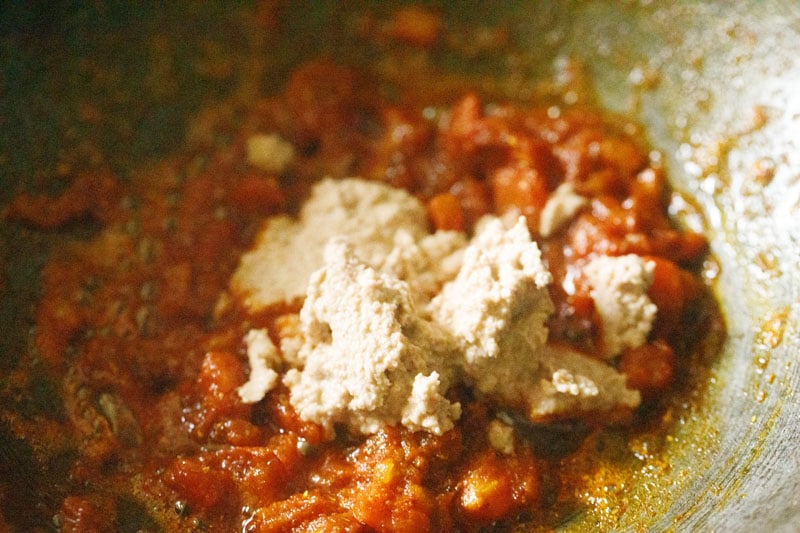
18. Mix and sauté for a minute.
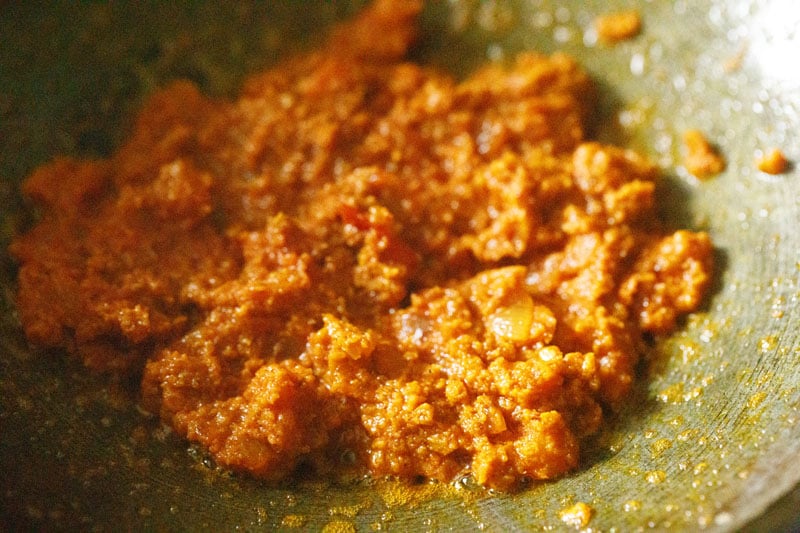
Making Bharli Vangi
19. Finally place the masala stuffed brinjals in the pan in one single layer.
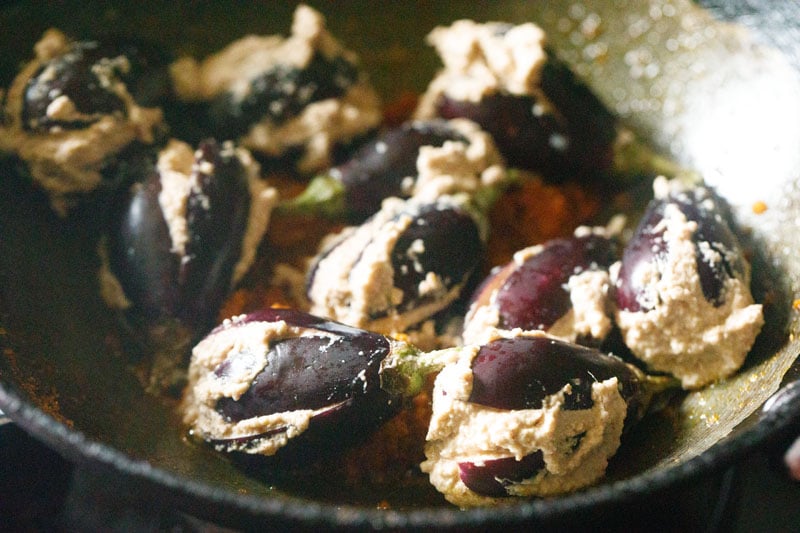
20. Gently mix the stuffed brinjals with the rest of the masala.
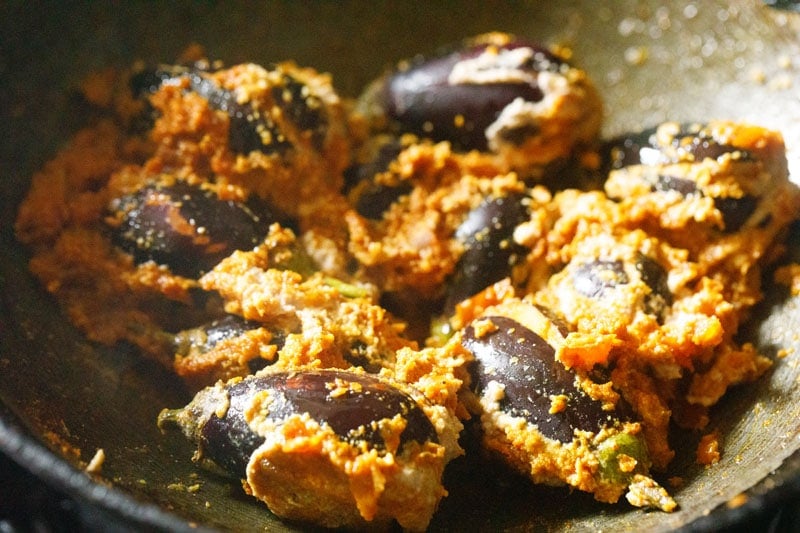
21. Add 1 cup water or as required. Mix the entire curry gently. For a more gravy, you can add more water. 1 cup water gives a slightly thick gravy.
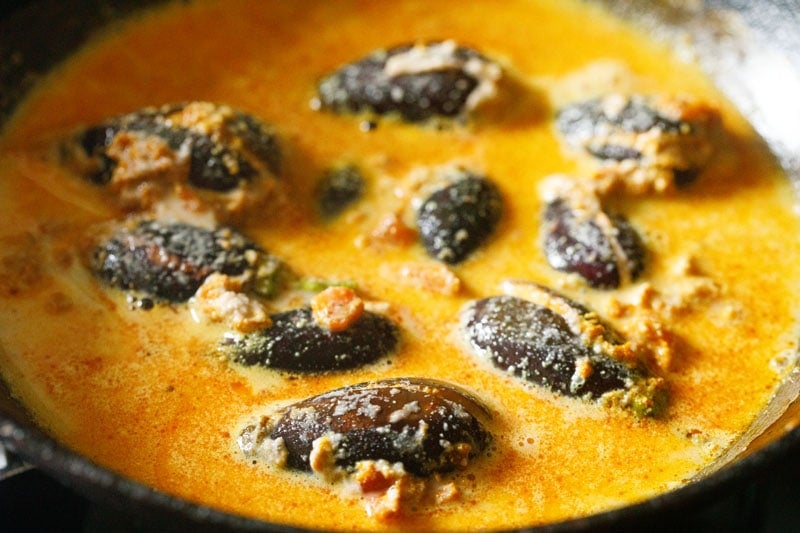
22. Add salt to taste.
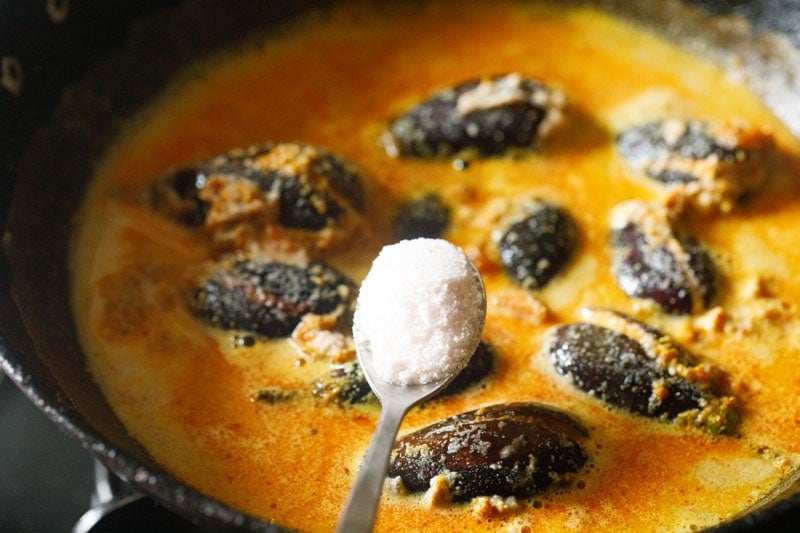
23. Cover and let the brinjals cook for 20 to 22 minutes on low to medium-low heat. Keep checking in between and if the stuffed brinjals looks a bit dry, then add some more water.
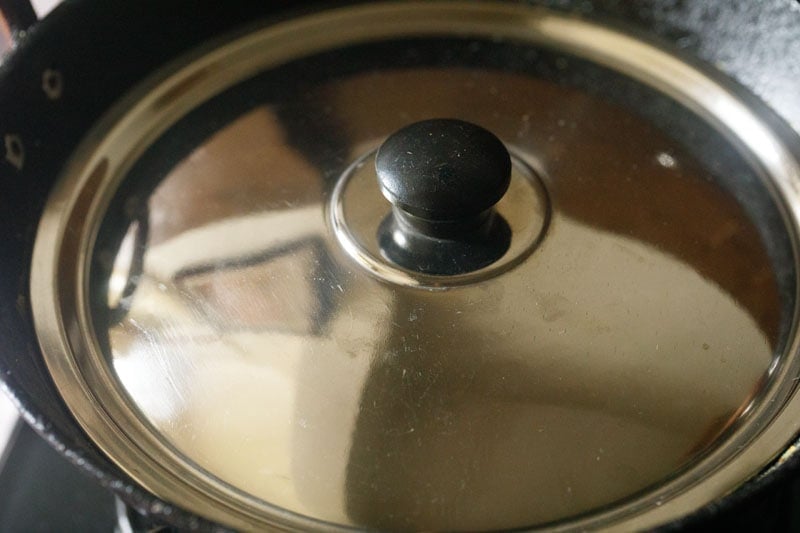
24. Switch off the heat, when the brinjals are fork tender. You will also see some oil floating on the top layer of the gravy. This means that the Bharli Vangi gravy or curry is cooked through.
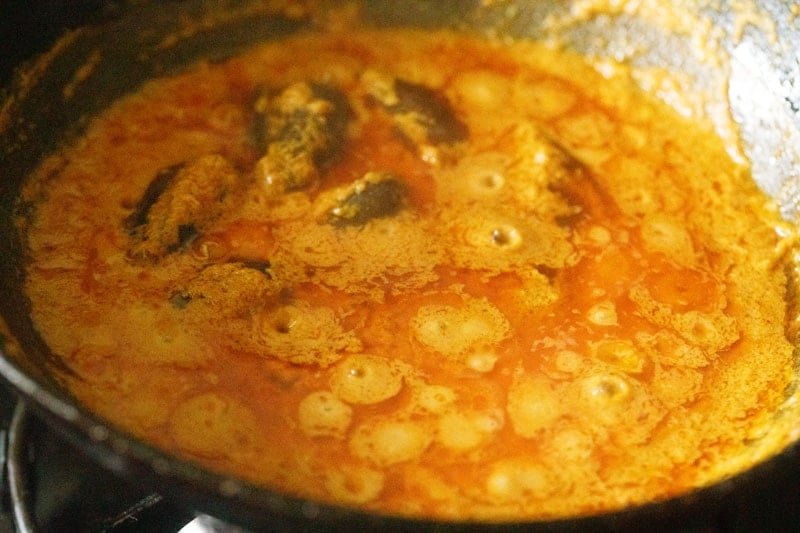
25. Add 2 to 3 tablespoons chopped coriander leaves.
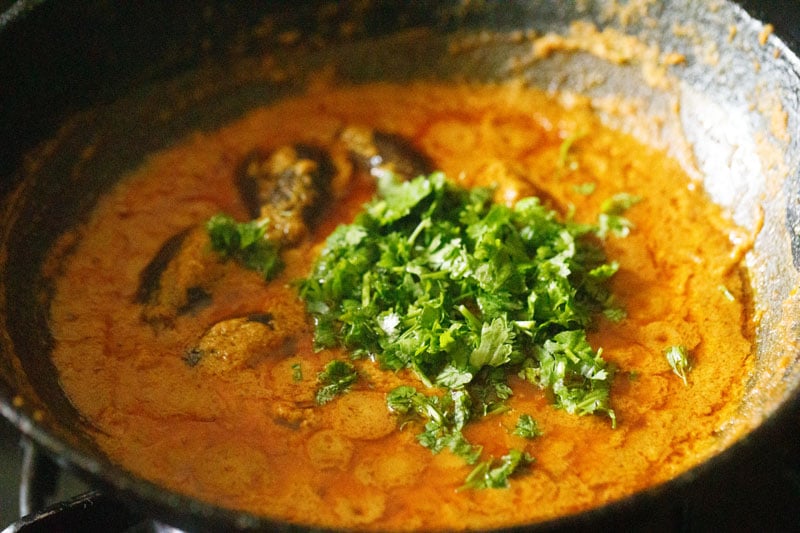
26. Serve Bharli Vangi hot or warm with steamed rice, chapati, bhakri, poli or paratha.
While serving, you can drizzle some lemon juice, if you want. You can also garnish with a few coriander leaves while serving.
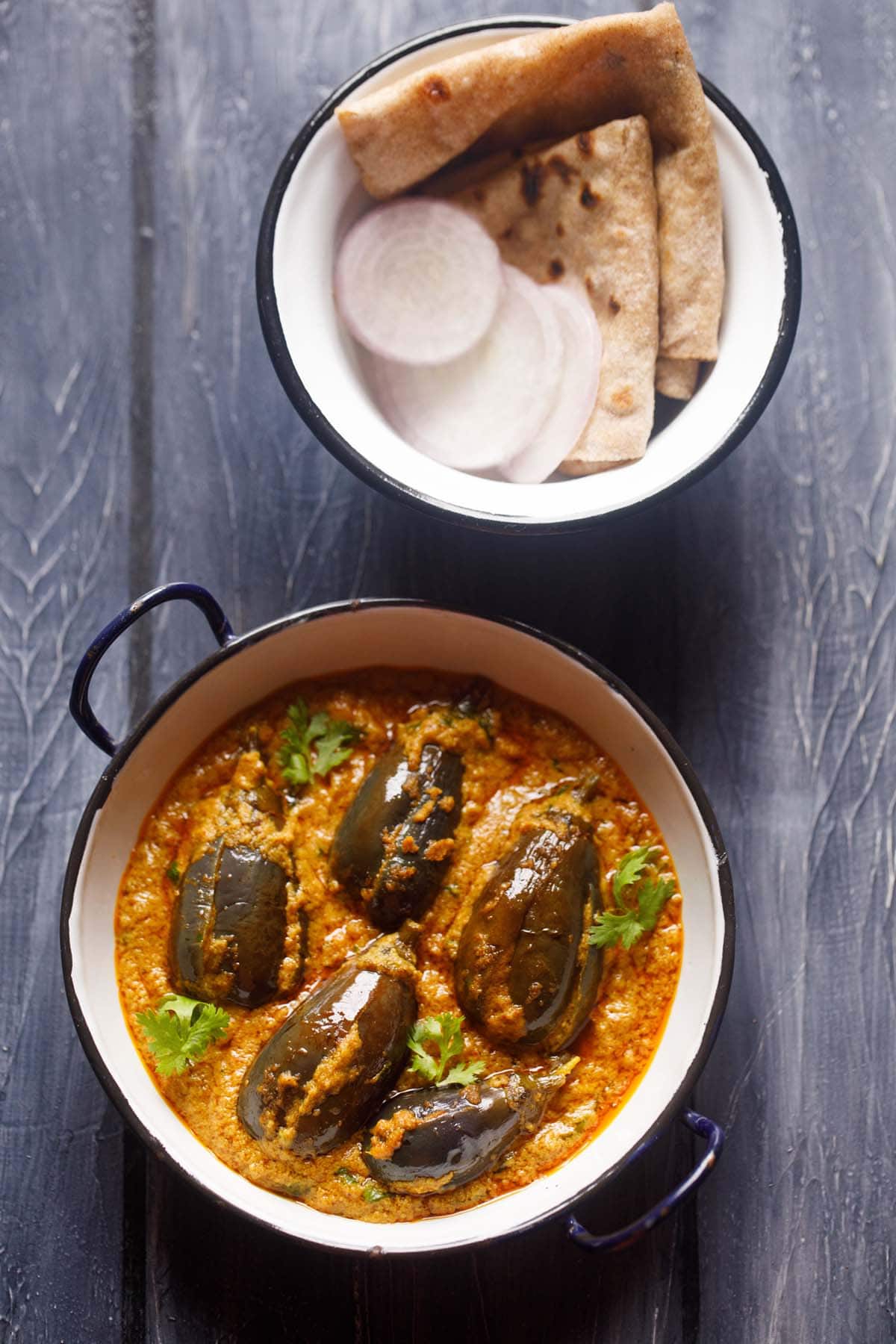
Expert Tips
- Eggplant: Use small or baby brinjals to make this recipe. These variety of brinjals soften and become mushy when cooked. Do not use the large variety of eggplant as they do not become mushy and remain spongy after cooking.
- Sourness: Tamarind can be used instead of tomatoes. If using tamarind, then add a bit of jaggery or sugar to balance the sour taste. Since tomatoes are added, no need to add jaggery.
- Coconut: You can even use fresh or frozen coconut. But the taste with either will be different.
- Spice alternative: In place of goda masala powder, you can also add garam masala powder in this dish.
- Make without stuffing brinjals: If you do not want to stuff brinjals, then chop them and soak them in salted water for 15 minutes. In this case, first sauté the onions and tomatoes. Add the ground masala paste, spice powders and sauté for 3 to 4 minutes till you see oil separating from the sides. Then, add chopped brinjals followed by water and salt. Cover and cook until brinjals are softened.
More Brinjal Recipes To Try!
Brinjal Recipes
Brinjal Recipes
Karnataka Recipes
Brinjal Recipes
Please be sure to rate the recipe in the recipe card or leave a comment below if you have made it. For more vegetarian inspirations, Sign Up for my emails or follow me on Instagram, Youtube, Facebook, Pinterest or Twitter.
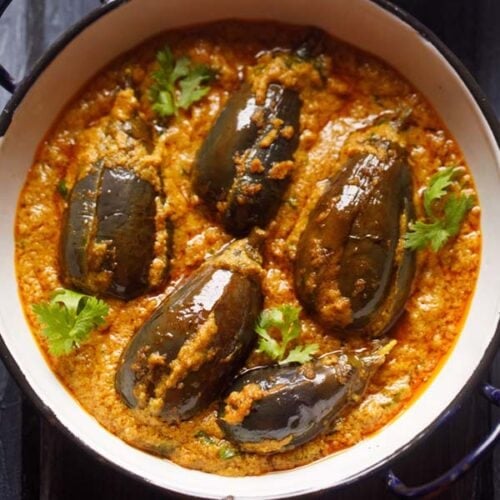
Bharli Vangi | Stuffed Brinjal
Ingredients
For stuffing masala
- ¼ cup peanuts
- ½ cup desiccated coconut or unsweetened shredded coconut
- 1 tablespoon white sesame seeds
- 5 to 6 garlic cloves – small to medium sized, peeled and chopped
- 1 inch ginger – peeled and chopped
- ¼ cup onions – roughly chopped
- 4 to 5 tablespoons water – for grinding or blending
Other ingredients
- 250 grams brinjals – small or baby brinjals
- 3 to 4 tablespoons peanut oil – can swap with sunflower oil or any neutral flavored oil
- ¼ cup onions – chopped
- ½ cup tomatoes – chopped
- 1 pinch asafoetida – hing, optional
- ½ teaspoon turmeric powder
- ½ teaspoon kashmiri red chili powder or red chilli powder
- ½ teaspoon coriander powder
- ½ teaspoon cumin powder
- 2 teaspoons Goda Masala or ½ teaspoon garam masala
- 1 cup water or add as required
- salt as required
- 2 to 3 tablespoons coriander leaves – chopped
Instructions
Preparation
- Rinse the brinjals first a few times in water. Cut each brinjal into four parts without breaking them.
- Slightly pull apart the brinjal wedges and check to see if there are any worms in them. If you see black spots or worms, discard the brinjal.
- Soak the brinjals in salted water for 15 mins. You can also dice them and soak in salted water.
- Dry roast the peanuts first, when they start to become brown and have a few blisters on them, add the white sesame seeds followed by desiccated coconut.
- Next add chopped ginger and garlic and stir to mix.
- Roast the coconut stirring non-stop until golden or browned and it should smell fragrant.
- Set aside this roasted mixture to cool.
- When the coconut, peanuts and sesame seeds cool, add them in a high-speed blender or grinder.
- Also add ¼ cup roughly chopped onions.
- Grind to a fine, thick and smooth paste with 4 to 5 tablespoons water. Make sure that the paste is not runny or thin.
- Transfer this paste into a bowl or a plate and set aside.
Follow this method if brinjals are not chopped
- Drain all the water thoroughly from the soaked brinjals. Place the brinjals on a plate or chopping board.
- Pat them dry with clean kitchen towel, if you prefer. With a spoon, stuff each brinjal with this ground masala. Set aside.
- In pan heat peanut oil. Add ¼ cup chopped onions and sauté them on low to medium-low heat until they turn light golden.
- Add the chopped tomatoes and sauté until they turn mushy.
- Next add these ground spice powders – turmeric powder, kashmiri red chilli powder, coriander powder, cumin powder, asafoetida.
- Also add either 2 teaspoons of goda masala or ½ teaspoon of garam masala.
- Stir to mix evenly and sauté for some seconds until the masala smells fragrant.
- Add the remaining ground coconut and peanut paste and sauté for a minute.
- Gently place the stuffed brinjals on the sautéed masala mixture. Mix gently to combine.
- Add 1 cup water and salt as needed. Cover with lid and on low to medium-low heat, simmer for 20 to 22 minutes or until the brinjals are fork tender.Do check a few times and if the gravy looks very thick, add some water.
- Turn off heat when the brinjals are fork tender. Lastly add chopped coriander leaves and mix.
- Serve Bharli Vangi hot or warm with rice or chapati or bhakri.
Follow this method if brinjals are chopped
- In pan heat oil, add the onions and sauté them till they soften.
- Add tomatoes and sauté until the tomatoes soften.
- Next add the prepared masala paste and sauté for 3 to 4 minutes or until you see oil releasing from the sides.
- Add the all the ground spice powders and sauté for a few seconds.
- Add in the chopped brinjals and stir to mix them with the masala paste in the pan
- Next add water, salt as per taste. Mix the entire curry.
- Cover with lid and let the brinjals cook until tender and softened. When the dish is ready, garnish with coriander leaves.
- Serve Bharli Vangi hot with steamed rice or poli or chapati.
Notes
- Recipes like these taste best when made with small or baby brinjals as they soften quickly and become mushy. Do not use the large and lighter variety of dark purple eggplants as they do not taste good in this recipe.
- You can add tamarind instead of tomatoes. If using tamarind, then add a bit of jaggery or sugar to balance the sour taste. Here since in the recipe, tomatoes are added, there is no need to add jaggery.
- You can opt to add fresh or frozen coconut instead of desiccated coconut. But the taste will change slightly.
- For a medium consistency gravy, add slightly more than 1 cup of water.
- To make a spicy Bharli Vangi, add more Kashmiri red chilli powder or use a spicy red chilli powder.
- The recipe cannot be scaled as is, due to its complex nature.
Nutrition Info (Approximate Values)
This Bharli Vangi recipe from the archives first published in July 2011 has been republished and updated on December 2022.
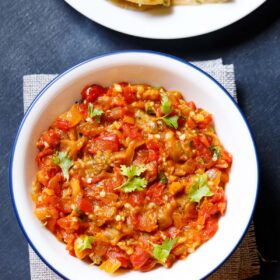
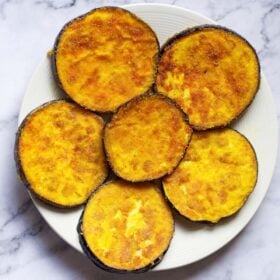
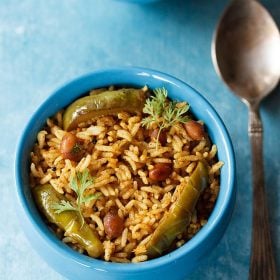
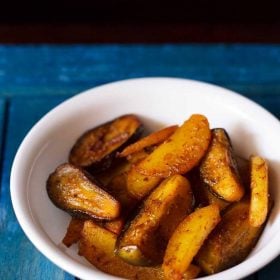








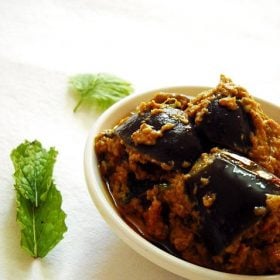
You made cooking so much easier,I regularly follow your recipes, it could be a simple Rasam or biriyani.Thanks much for sharing.
thanks a lot. glad to read your comment. most welcome and happy cooking.
great recipe despite not using sesame seeds and adding more peanuts!
thanks meghna for this feedback on bharli vangi.
Amazing recipe. Made it without onion and garlic and came out yummy! Love your recipes and the ease with which you cook. Very inspiring. Thank you so much.
thanks for sharing harilila. welcome and happy cooking.
Dassana, Can you suggest some way to minimize tears while chopping onions?
you can soak halved onions in water for some 15 to 20 minutes and them chop them. this will reduce the tears coming from eyes while chopping onions. i had also heard of keeping bread in the mouth while chopping onions, but don’t know if it works. what works for me while cutting onions is that i wear specs and the soaking method ????
I had read about the soaking method but didn’t know the duration. Once I tried after soaking for some seconds. Obviously it didn’t help much.
Another thing was that after soaking, I found the onions too slippery to cut. I guess after soaking, one should just place the halved piece on board & chop it chef style- without requiring to move the slippery slices.
Specs.. That’s interesting. I hope you mean the usual specs that are worn for eye power correction. There are some sites that suggest wearing scuba/swimming goggles, which I think will make one look very weird while working in the kitchen..
ruchi, soak for at least some minutes. it does help. slipperiness is due to the thin transparent cover on the onions. if you remove this cover, the onions won’t feel slippery. the specs is the regular spectacles. i have a minimum number for short sightedness. hence even when cooking i have to use specs. or else it puts strain on the eyes. plus also while using camera, i have to use specs. even i read about the googles which will look funny when working in the kitchen.
Absolutely loved this receipe. Followed it to the T with a little variations here and there. But the result was damn nice. Thanks for sharing it!
Welcome Rupali. Glad to know that you liked bharli vangi recipe.